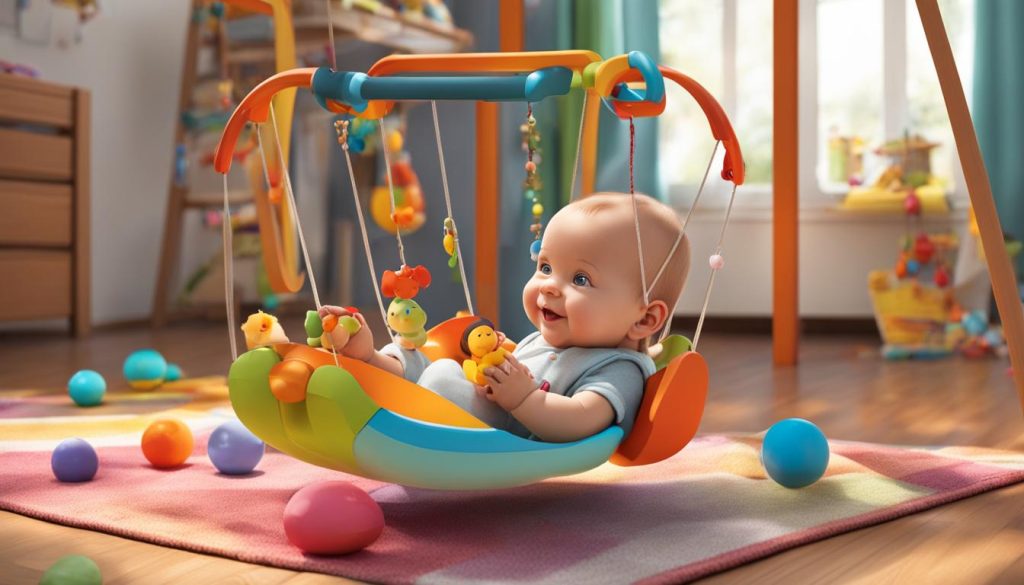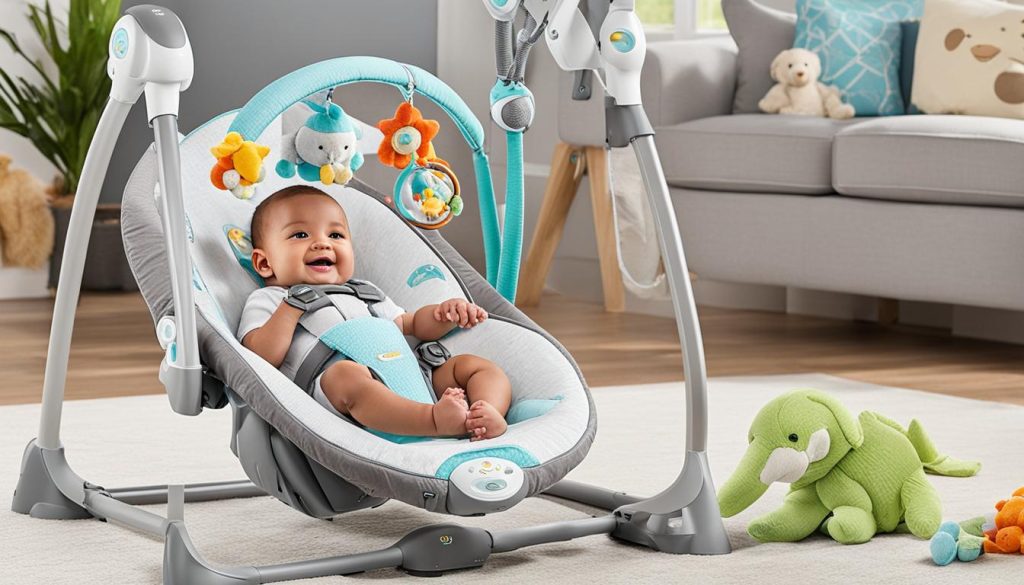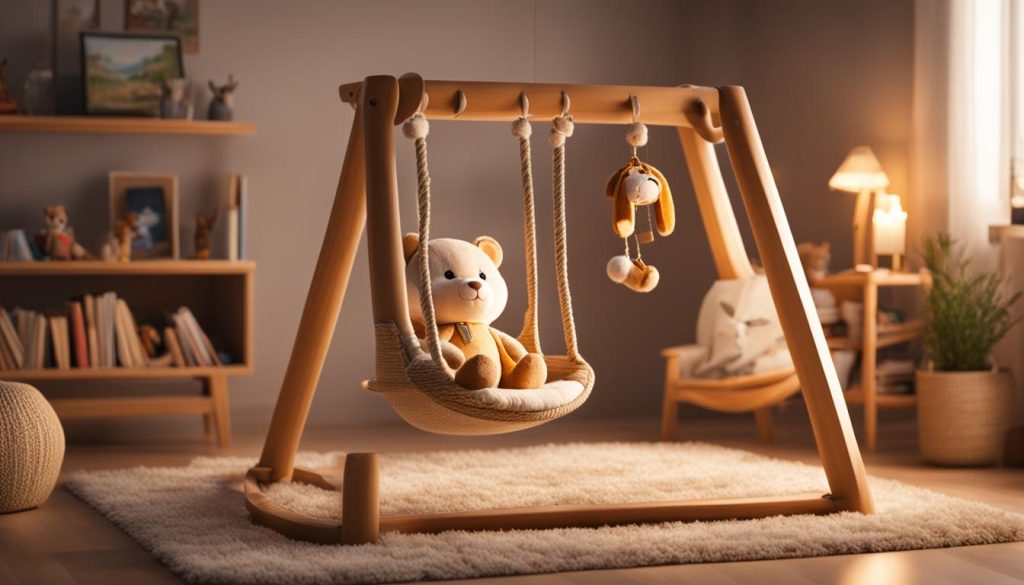As a parent, one of the questions you may have is how long can you use a baby swing? It is essential to understand the recommended age for a baby swing and the safety guidelines associated with its use. In this article, I will provide you with all the information you need to ensure the safe and effective use of a baby swing for your little one.
Firstly, let’s address the lifespan of a baby swing. Baby swings are safe to use as long as your baby is under close supervision. However, it is crucial to be aware of the dos and don’ts of using a baby swing to ensure their safety. Infants should never sleep in a baby swing as this can increase the risk of suffocation. The American Academy of Pediatrics advises that babies younger than 4 months should always be seated in the swing’s most reclined position to prevent suffocation.
Between 2009 and 2012, there were reported incidents related to baby swings, including two infant deaths and 24 injuries. To address these concerns, the Consumer Product Safety Commission (CPSC) issued new safety standards for baby swings in 2012. However, caregivers should still follow safe sleep recommendations and guidelines. Always check for recalls on baby swings, thoroughly read the instruction manual, and ensure that the swing’s weight limits are followed.
So, how long should you use a baby swing? The duration of use for a baby swing depends on the weight limits provided by the manufacturer. It is essential to stop using the swing when your baby outgrows it or shows signs of no longer being interested in it. Your baby’s safety and comfort should always be the top priority.
In the following sections of this article, we will explore the benefits of using a baby swing for soothing and entertaining infants, different types of baby swings, safety guidelines and precautions, when to stop using a baby swing, and tips for maximizing its use while ensuring overall safety. I hope this article will provide you with the knowledge and confidence to make informed decisions when it comes to using a baby swing for your little one.
The Benefits of Using a Baby Swing for Soothing and Entertaining Infants
Using a baby swing can provide numerous benefits for soothing and entertaining infants. The gentle rocking motion of a baby swing mimics the womb environment, which has a calming effect on babies. It helps to soothe fussy babies and can promote better sleep. The rhythmic motion of the swing provides sensory stimulation and can distract a baby from discomfort or irritability. It creates a comforting and familiar experience for the baby, replicating the feeling of being held and rocked by a caregiver.
Additionally, many baby swings come with built-in features such as music, sounds, and toys. These additional features can further engage and entertain babies, stimulating their senses and encouraging exploration. The captivating music and sounds can capture the baby’s attention and provide auditory stimulation. The dangling toys and mobiles attached to the swing can help develop their visual tracking skills and hand-eye coordination. These features make the baby swing not only a soothing tool but also an entertaining one.
Using a baby swing has the added benefit of giving parents a break while still providing a comforting and entertaining experience for their child. It allows parents to attend to other tasks or take a moment for self-care while knowing that their baby is safe and content in the swing. This can help alleviate parental stress and exhaustion, allowing parents to recharge and maintain their well-being. The baby swing becomes a valuable parenting tool, providing soothing and entertainment for the baby while giving parents some much-needed respite.
In summary, the benefits of using a baby swing for soothing and entertaining infants are numerous. Its gentle rocking motion replicates the feeling of being held and rocked by a caregiver, providing a soothing and calming effect. The additional features such as music, sounds, and toys enhance sensory stimulation and encourage exploration. Using a baby swing also allows parents to have a break while still ensuring their baby’s comfort and entertainment. It is important to ensure the safe and responsible use of baby swings, following the manufacturer’s guidelines and adhering to safety precautions.
Different Types of Baby Swings and Factors to Consider
When it comes to selecting a baby swing, there are several factors to consider. Not only are there different types of baby swings available, but each swing also comes with its own set of features and specifications. Understanding these options can help you choose the best baby swing for your little one.
Types of Baby Swings
There are various types of baby swings on the market, each offering unique benefits. Some popular options include:
- Full-size swings: These are larger and sturdier swings that often come with a wide range of features such as different swinging motions, music, and toys.
- Portable swings: These are designed to be lightweight and compact, making them easy to transport and store. They are great for families on the go or for those with limited space.
- Convertible swings: These swings can be transformed into stationary seats, providing versatility as your baby grows. They are ideal for long-term use and can save you money in the long run.
Factors to Consider
In addition to the type of swing, there are several factors to consider when selecting a baby swing. These include:
- Baby swing safety features: Look for swings with secure harnesses, sturdy construction, and stability to ensure the safety of your baby.
- Baby swing motion types: Different swings offer different motion types, such as back-and-forth swinging or side-to-side swinging. Consider your baby’s preferences and comfort when choosing the motion type.
- Ease of use: Check for features such as adjustable speed settings, easy assembling and disassembling, and convenient cleaning methods. These factors can make your experience with the swing more enjoyable and hassle-free.
By considering these factors and researching different baby swing options, you can find the perfect swing that meets your baby’s needs and provides a safe and soothing experience.
| Type | Features | Benefits |
|---|---|---|
| Full-size swings | Multiple swinging motions, music, toys | Entertainment and stimulation for baby |
| Portable swings | Lightweight, compact design | Convenient for travel and limited spaces |
| Convertible swings | Transform into stationary seats | Long-term use and cost savings |
“Choosing the right baby swing involves considering the different types available and the specific features that meet your baby’s needs. Whether you opt for a full-size swing, portable swing, or convertible swing, make sure to prioritize baby swing safety features, such as secure harnesses and stability. Additionally, consider factors like motion types and ease of use to enhance your baby’s comfort and your convenience. By making an informed decision, you can ensure that your baby enjoys the soothing and entertaining experience a baby swing provides.” – Baby Expert
Baby Swing Safety Guidelines and Precautions
When using a baby swing, it is crucial to prioritize the safety of your little one. By following these safety guidelines and precautions, you can ensure a secure and enjoyable experience for your baby:
- Read the instruction manual: Before using the baby swing, thoroughly read and understand the manufacturer’s instructions. Familiarize yourself with the recommended weight limits, assembly process, and any specific safety recommendations.
- Check for recalls: Regularly check for any recalls or safety alerts related to your specific baby swing model. This is especially important if you have a secondhand or hand-me-down swing.
- Secure the swing properly: Ensure that the swing is placed on a flat and stable surface to prevent tipping or folding. Follow the manufacturer’s instructions for securing the swing to avoid any accidents or mishaps.
- Position your baby correctly: For infants under four months, it is essential to place them in the swing’s most reclined position. This helps reduce the risk of suffocation and allows for proper airflow.
- Use the safety straps: Always use the provided safety straps and ensure they are correctly fastened. This helps keep your baby secure and prevents them from sliding or falling out of the swing.
- Keep toys securely attached: If your baby swing comes with detachable toys, make sure they are securely attached according to the manufacturer’s instructions. Loose or unsecured toys can pose a choking hazard.
- Never leave your baby unattended: It is crucial to supervise your baby at all times while they are in the swing. Never leave them unattended, even for a short period. If you need to step away, take your baby out of the swing and place them in a safe area.
Remember, the safety of your baby should always be your top priority. By following these guidelines and taking necessary precautions, you can ensure a safe and enjoyable experience with your baby swing.
By adhering to these safety guidelines and precautions, you can create a secure environment for your baby while using a baby swing. Always prioritize the well-being of your little one and stay informed about any safety alerts or recalls related to your specific baby swing model.
When to Stop Using a Baby Swing
Knowing when to stop using a baby swing is essential for the safety and comfort of your child. While baby swings can be a great tool for soothing and entertaining infants, there comes a time when they outgrow them or lose interest. Here are some signs and guidelines to help you determine when it’s time to stop using a baby swing.
Signs your baby has outgrown the swing:
- Your baby is attempting to climb out of the swing
- Your baby seems cramped or uncomfortable in the swing
- Your baby shows disinterest or fussiness while in the swing
It’s important to note that the weight limits set by the manufacturer should be followed. Once your baby exceeds the recommended weight, it’s time to transition to other forms of soothing or play. Additionally, as your baby grows and develops, their preferences and needs change. Paying attention to their cues and adjusting their environment accordingly is key.
When it comes to the age limit for a baby swing, there isn’t a specific cutoff. It varies depending on the weight limits set by the manufacturer and the developmental milestones of your baby. It’s essential to follow the guidelines provided by the manufacturer to ensure the safety and well-being of your child.
| Manufacturer | Weight Limit | Age Range |
|---|---|---|
| Brand A | 20 lbs | 0-9 months |
| Brand B | 25 lbs | 0-12 months |
| Brand C | 30 lbs | 0-18 months |
Always refer to the specific guidelines provided by the manufacturer of your baby swing. It’s important to prioritize your baby’s safety and comfort, and transitioning to other forms of play and soothing as they outgrow the swing is a natural part of their development.
Maximizing the Use of a Baby Swing and Ensuring Overall Safety
When it comes to using a baby swing, maximizing both its benefits and safety is essential. To make the most of your baby swing experience while keeping your little one safe, here are a few important tips:
First and foremost, always stay informed about any recalls affecting your baby swing. Regularly check for recalls, especially if you have a secondhand or hand-me-down swing, to ensure that it meets the latest safety standards.
Next, carefully read and follow the instructions provided by the manufacturer. These instructions are designed to optimize your baby’s safety during swing use. Pay attention to weight limits and any specific safety recommendations for your particular swing model.
Remember to test the stability of the swing before placing your baby in it. Ensure that it is on an even surface and properly secured. Angle the swing at a safe position, particularly for young infants, to prevent any discomfort or potential harm.
Additionally, never leave your baby unattended while they are in the swing. Always use the safety straps provided and ensure they are securely fastened. This will help prevent any accidents or falls. Keep the swing clean and free from hazards such as loose toys or bedding to maintain a safe environment for your baby.
By following these simple tips, you can maximize the use of your baby swing while ensuring the safety of your little one. Remember, prioritizing safety is key to providing a comfortable and enjoyable experience for both you and your baby.





